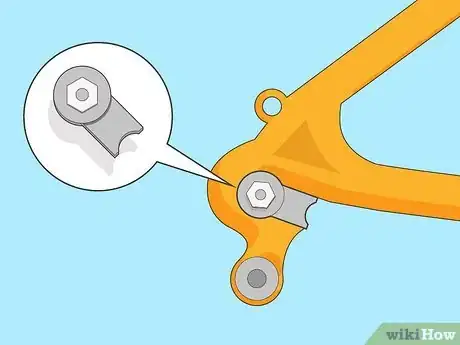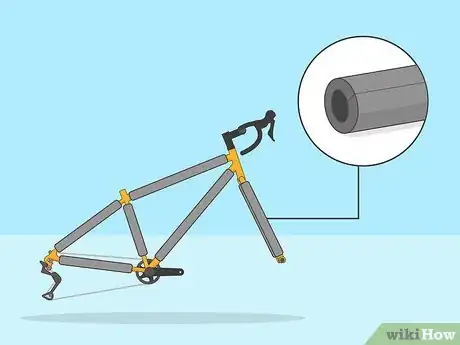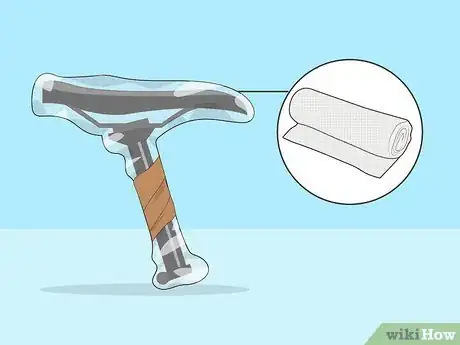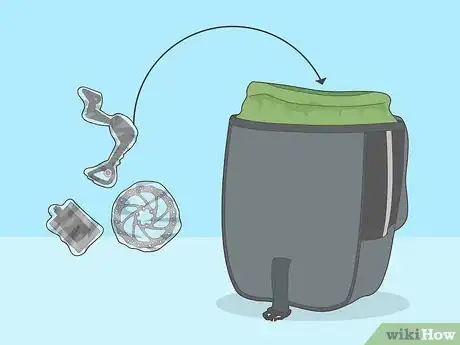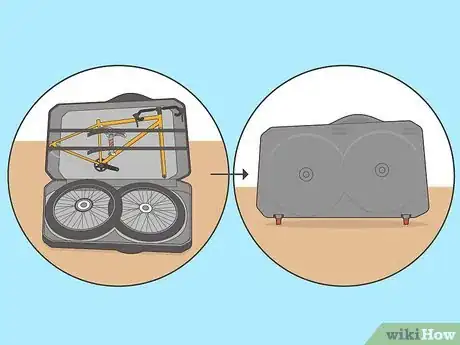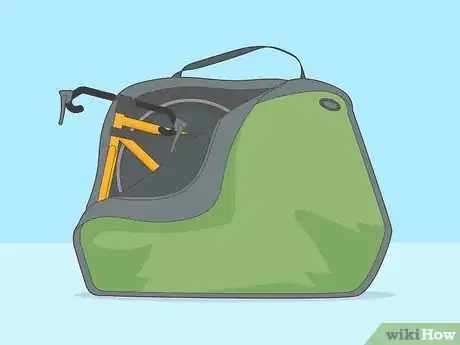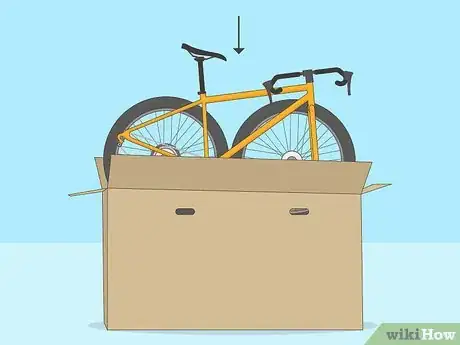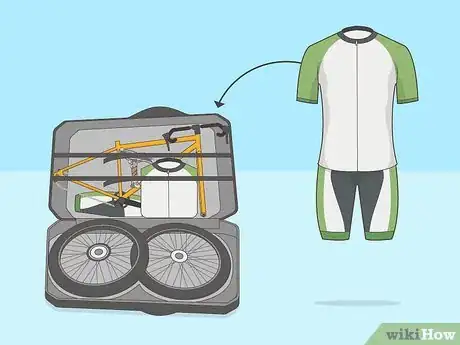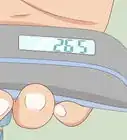This article was co-authored by wikiHow Staff. Our trained team of editors and researchers validate articles for accuracy and comprehensiveness. wikiHow's Content Management Team carefully monitors the work from our editorial staff to ensure that each article is backed by trusted research and meets our high quality standards.
There are 7 references cited in this article, which can be found at the bottom of the page.
This article has been viewed 8,835 times.
Learn more...
Taking your bike with you on a trip lets you explore your destination in a whole different way. If you’re planning to travel with your bike, make sure to pack it correctly for air travel to guarantee it arrives in good shape. We’ve compiled a bunch of great tips to help you do just this. These are tried-and-true methods suggested by people who’ve flown with bikes before, so take heed!
Steps
Choose an airline that lets you check your bike as luggage.
-
Some airlines have more restrictive luggage policies than others. These can make it difficult or expensive to fly with your bike. Read the checked baggage policies for different airlines to find out the max weight, size, and number of bags and to make sure they allow bikes. Pick an airline for which your packed bike doesn’t exceed the limits.[1] X Research source
- If your bike exceeds the weight or size limits for an airline, it doesn’t necessarily mean you can’t fly with it. You can usually pay an extra fee for larger or overweight items. In this case, opt for an airline that has a more affordable extra baggage fee.
- Some airlines also have specific policies regarding bikes. For instance, they may charge an extra bike fee of $30-$100. Make sure you read carefully to find out about any such fees before booking a flight.
Take your bike apart.
-
This makes it easier to pack in a bag or a box. Remove the pedals, the seat post with the saddle, the rear derailleur, and the wheels. Tighten all the bolts on the pieces you removed after you disassemble the bike, so they don’t fall out and get lost in transit.[2] X Research source [3] X Research source
- Removing the handlebars is another optional step. It’s a good idea if your handlebars are on the bigger side, but if they’re pretty small you can just turn them to the side when you pack your bike.
- If your bike has disc brakes, remove these to pack them separately as well.
Put spacers between the dropouts on the frame and the fork.
-
This prevents damage to the dropouts. The dropouts are the grooves at the end of the fork and the frame that the axles of your bike’s wheels sit in. Dropout spacers fill the space between the dropouts to prevent them from getting bent. Slide the spacers into the dropout grooves and tighten them with the lever lock. Flip the lever down to lock the spacers in place.[4] X Research source
- You can either buy a dropout spacer kit online or from a bike shop or you can ask your local shop if they have any spare plastic spacers that come with the bikes they sell that they’re willing to give you.
Cover the main tubes of the frame with foam pipe lagging.
-
This protects the tubes from scratching in transit. Cut the pipe lagging to length using a box cutter or sharp scissors. Slide the foam pieces over the bike frame’s tubes horizontally where the foam has a slit down the middle.[5] X Research source
- You can buy foam pipe lagging at most DIY and home improvement stores. Ask an employee where the pipe insulation is to find it.
Wrap individual components in bubble wrap.
-
This provides lots of padding to prevent damage during the trip. Wrap things like the seat, wheels, derailleurs, and disc brakes in a few layers of bubble wrap.[6] X Research source Secure the wrap tightly with packing tape.[7] X Research source
- Bubble wrap and packing tape are available at home improvement centers and packing supply stores.
Place small components inside a separate bag.
-
This keeps them from moving around and bumping into things in transit. If you’re bringing bike bags, such as panniers, put small parts like disc brakes and derailleurs inside them. However, don’t pack components in carry-on bags to avoid problems with airport security.[8] X Research source
- Small bike bags may fit alongside your bike when you pack it. Or, they can go inside of another larger checked bag or suitcase.
Pack your bike in a bike box for the most protection.
-
Bike boxes provide a hard, durable shell for your bike. These boxes are shaped to fit the parts of a disassembled bike. Place the frame on the foam padding in the bottom and strap it into place with the straps inside the box. Strap the other components, like the seat post, wherever they fit around the frame. Place the wheels into the round slots in the lid of the box.[9] X Research source
- You can buy these boxes online or at a bike shop. However, they can be quite expensive, sometimes costing hundreds of dollars.
- Make sure you get a bike box that fits your frame and wheel size.
Put your bike in a bike bag for a cheaper option.
-
These are soft cases that still offer good protection for your bike. Place your bike frame inside the bag, upside-down. Strap it into place using the attached straps inside the bag. Use free provided straps to secure other components like the seat post into place. Slide the wheels inside the pouches on the top part of the bag.[10] X Research source
- You can buy bike bags online or from bike shops. They are more affordable than bike boxes, costing as little as $30.
Pack your bike in a cardboard box if you’re really on a budget.
-
Cardboard boxes offer a minimal amount of protection. Slide your bike frame into the box, right-side-up. Slide the wheels and other components in around the frame next. Stuff all the empty spaces inside the box with bubble wrap to provide more padding and keep things from moving around. Seal the box up well with duct tape.[11] X Research source
- Ask around in local bike shops for spare cardboard boxes that the bikes they sell come in.
- Another way to separate pieces and add protection is to wrap them in smaller pieces of cardboard inside the box.
Pack your riding gear along with the bike.
-
This helps you get the most out of your checked luggage. Cram soft things like panniers or riding clothes in around the parts of your bike. This also adds more padding for the parts. Try to fit your helmet and any other accessories inside the box or bag with your bike as well.[12] X Research source
- Zip-tie or strap accessories to the frame of your bike to secure them in place or use any of the attached straps that are free if you’re using a bike bag or bike box.
You Might Also Like


 How to Find Lost or Delayed Luggage while Traveling
How to Find Lost or Delayed Luggage while Traveling

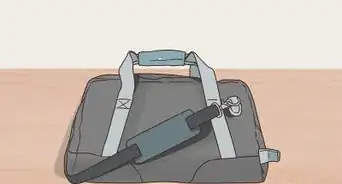

 3 Places to Buy Abandoned Airport Luggage
3 Places to Buy Abandoned Airport Luggage

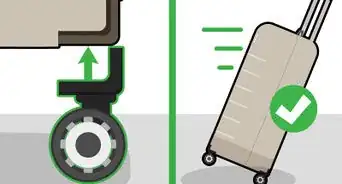



References
- ↑ https://www.bicycling.com/skills-tips/a26358342/best-airlines-for-cyclists/
- ↑ https://www.redbull.com/int-en/how-to-become-pro-at-travelling-with-your-bike
- ↑ https://www.bikeradar.com/features/routes-and-rides/how-to-pack-your-road-bike-for-a-trip-abroad/
- ↑ https://road.cc/content/feature/stuff-they-never-tell-you-about-flying-your-bike-271269
- ↑ https://www.cyclinguk.org/cyclists-library/bikes-public-transport/bikes-air
- ↑ https://www.redbull.com/int-en/how-to-become-pro-at-travelling-with-your-bike
- ↑ https://www.cyclinguk.org/cyclists-library/bikes-public-transport/bikes-air
- ↑ https://www.cyclinguk.org/cyclists-library/bikes-public-transport/bikes-air
- ↑ https://www.welovecycling.com/wide/2017/08/15/get-bike-ready-air-travel/
About This Article



